
The Jabez Smith House is a historic house museum at 259 North Road in Groton, Connecticut. Built about 1783, it is the only 18th-century farmhouse to survive on Groton's Poquonock Bridge area, which was once its principal agricultural area. It is owned by the town of Groton and open to the public on weekends from April through November. It features 18th and 19th-century antiques. The house was listed on the National Register of Historic Places on May 15, 1981.
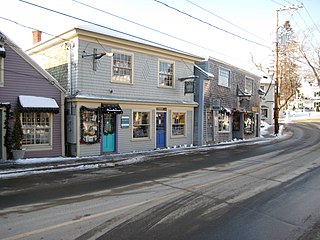
The Kennebunkport Historic District encompasses most of the village center of Kennebunkport, Maine. It includes the town's highest concentration of historic architecture, with many buildings from the late 18th and early 19th century, when Kennebunkport was at its height as a shipping and shipbuilding center. The district was added to the National Register of Historic Places on May 6, 1976.
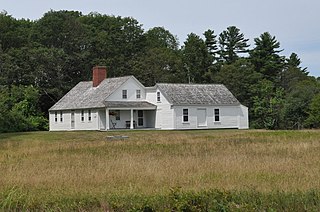
The Tarr–Eaton House, also known as Tarr–Eaton–Hackett House, is an historic house at 906 Harpswell Neck Road in Harpswell, Maine. Built before 1783 and enlarged about 1840, it is a well-preserved 18th-century Cape with added Greek Revival features, and one of Harpswell's few surviving pre-Revolutionary War buildings. It was listed on the National Register of Historic Places in 2001.

The Hatch House is an historic house at 2104 Sanford Road in Wells, Maine. Built about 1800, it is one of a collection of well-preserved 18th-century Cape style houses in Wells. It was listed on the National Register of Historic Places in 1979, listed as being in the North Berwick area. However, it is physically located in the town of Wells.
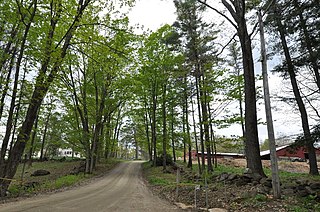
The John Adams Homestead/Wellscroft is a historic farmstead off West Sunset Hill Road in Harrisville, New Hampshire. The oldest portion of the farm's main house is a 1+1⁄2-story wood-frame structure built in the 1770s. It is one of the least-altered examples of early Cape style architecture in Harrisville, lacking typical alterations such as the additions of dormers and changes to the window sizes, locations, and shapes. The farmstead, including outbuildings and an area of roughly 2 acres (0.81 ha) distinct from the larger farm property, was listed on the National Register of Historic Places.
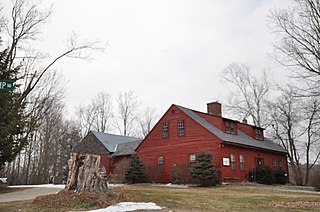
The Moses Eaton Jr. House is a historic house on Hancock Road in Harrisville, New Hampshire. Built about 1790, it is one of the oldest houses in the eastern part of Harrisville, and was home for fifty years to the itinerant folk stenciler Moses Eaton Jr. The house was listed on the National Register of Historic Places in 1988.

The Kendall Cottage is a historic house on Breed Road in Harrisville, New Hampshire. Built in 1798, it is a well-preserved example of an early Cape-style hill country farmhouse, and one of a small number of surviving 18th-century buildings in the town. It was listed on the National Register of Historic Places in 1988.

The McClure-Hilton House is a historic house at 16 Tinker Road in Merrimack, New Hampshire. The oldest portion of this 1+1⁄2-story Cape style house was built c. 1741, and is one of the oldest surviving houses in the area. It was owned by the same family for over 200 years, and its interior includes stencilwork that may have been made by Moses Eaton Jr., an itinerant artist of the 19th century. The property also includes a barn, located on the other side of Tinker Road, which is of great antiquity. The property was listed on the National Register of Historic Places in 1989.
The Burgess House is a historic house on Burgess Road, just east of Austin Road in Sebec, Maine, United States. The oldest portion of this wood-frame house dates to about 1816, and was built by Ichabod Young, who erected the first fulling mill in Piscataquis County. The house is most remarkable for its high-quality interior woodwork, and for the artwork on the walls of several of its rooms, which includes paintings by Rufus Porter and stencilwork by Moses Eaton, Jr., two noted itinerant artists of the early-to-mid 19th century. The house was listed on the National Register of Historic Places in 1978.

The Early Cape houses of Wells, Maine, are a collection of 18th-century Cape style houses in or near the town of Wells, Maine. The town has a concentration of these houses that is unusual in the state of Maine. In the 1970s the town conducted a detailed street survey, in which 19 historically significant 18th-century Cape houses were identified either in or just outside the municipal boundaries. These buildings were subsequently listed on the National Register of Historic Places in December 1979.
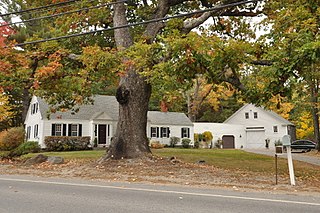
The Levi Foss House is a historic house on Maine State Route 35 on the Dayton side of the village of Goodwins Mills, Maine. Built about 1815, it is a well-preserved example of an early 19th-century connected farmstead with Federal and Greek Revival styling. It was listed on the National Register of Historic Places in 1984.

The Kennebunk Historic District encompasses a large portion of the historic town center of Kennebunk, Maine. Established in 1736, the district includes a significant number of fairly high-style houses from the late 18th and early 19th centuries, when Kennebunk was at its height as a shipbuilding and maritime shipping center. The district was listed on the National Register of Historic Places in 1974.

The Paul Family Farm is a historic farmstead at 106 Depot Road in Eliot, Maine. Consisting of a well-preserved early-19th century Federal style farmhouse and a small collection of early-20th century outbuildings, it is a representative example of 19th-century farming in the area. The farmhouse parlor is further notable for the c. 1820s stencilwork on its walls. The property was listed on the National Register of Historic Places in 1998.

The Dyer–Hutchinson Farm is a historic farm property at 1148 Sawyer Road in Cape Elizabeth, Maine. Established about 1790, it is one of the few surviving 18th-century farms in the town, and was in the hands of two families for about 200 years. It is now operated as the Old Farm Christmas Place, with some of its land devoted to the cultivation of Christmas trees. The property was listed on the National Register of Historic Places in 1997.

The William Colburn House is a historic house at 91 Bennoch Road in Orono, Maine. It was built about 1780 by William Colburn, one of the area's first white settlers, and is one of the few 18th-century houses surviving in Maine's central interior. It was listed on the National Register of Historic Places in 1973.

The Paine Neighborhood Historic District of Standish, Maine encompasses a small collection of rural properties that were all developed within a short period of time by members of the Paine family. Included are three late 18th-century houses and the family cemetery. The area provides a view of early settlement patterns in Maine's interior. The district was listed on the National Register of Historic Places in 1985.

The John Williams House is a historic house located on Pond Road in Mount Vernon, Maine. Built in 1827, this modest Cape is regarded for its high quality interior woodwork, and well-preserved stencilwork attributed to folk artist Moses Eaton. The house was listed on the National Register of Historic Places on December 6, 1984.

The Edmund and Rachel Clark Homestead is a historic farmstead in China, Maine. The property was developed beginning late in 18th century by one of the town's first settlers. It includes a house whose oldest portion dates to about 1789 and was never fitted with modern heat, plumbing, or electricity, and the archaeological remains of farm outbuildings. It was listed on the National Register of Historic Places in 2006.
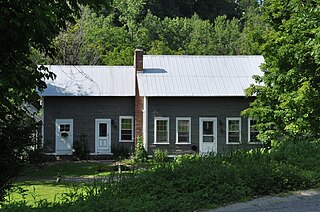
The Royalton Mill Complex is a three-building residential site in what is now a rural setting of Royalton, Vermont. The two houses and barn are historically associated with a mill, whose breached dams and remnant foundations lie just to the north. One of the houses, built about 1780, is believed to be Royalton's oldest surviving building. The complex was listed on the National Register of Historic Places in 1983.

The Sanford Road Historic District encompasses a small cluster of late 18th and early 19th-century farmsteads on Sanford Road in Southbury, Connecticut. The two farmhouses on the property are both associated with the locally prominent Stiles family, and typify Southbury's rural architecture of the period. The district was listed on the National Register of Historic Places in 1993.





















